MGTS7621 Reflective Journal: Employability and Personal Growth
VerifiedAdded on 2023/06/07
|6
|1458
|52
Journal and Reflective Writing
AI Summary
This reflective journal delves into the crucial aspects of employability and personal adaptability, drawing upon experiences from a Week 5 seminar and applying the SEAL model (Situation, Effect, Action, Learning). The author reflects on the importance of self-assessment in understanding personal traits and how they align with career choices. The journal discusses the three dimensions of employability: career identity, personal adaptability, and social and human capital. It highlights the impact of understanding one's personality, particularly in relation to job fit, and details the actions taken to conduct a self-analysis using the Big 5 Model. The author reflects on past job experiences, identifies personal strengths and weaknesses, and formulates a career plan that aligns with their personality as an introvert. The journal concludes with key learnings about the continuous nature of self-analysis and its significance in making informed career decisions.
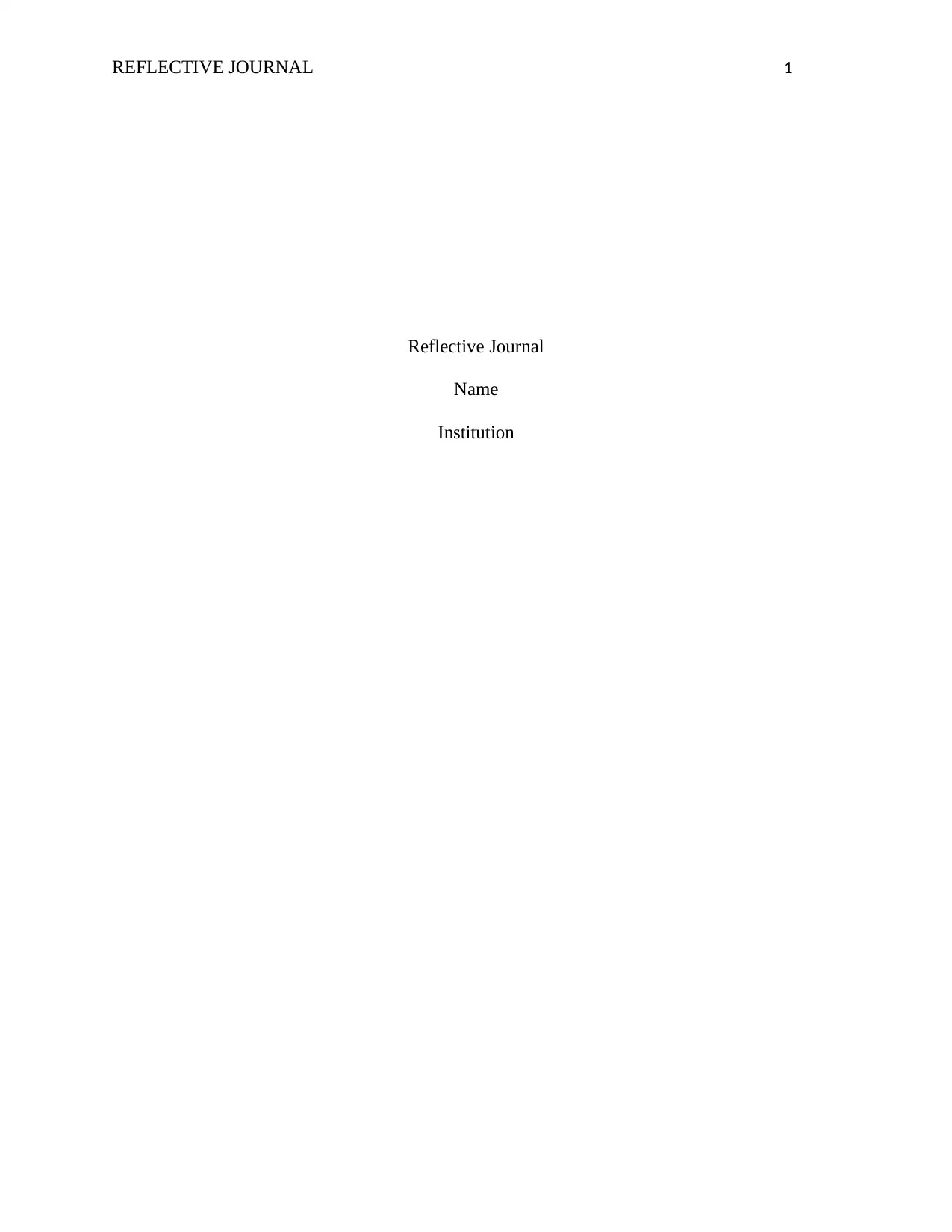
REFLECTIVE JOURNAL 1
Reflective Journal
Name
Institution
Reflective Journal
Name
Institution
Paraphrase This Document
Need a fresh take? Get an instant paraphrase of this document with our AI Paraphraser
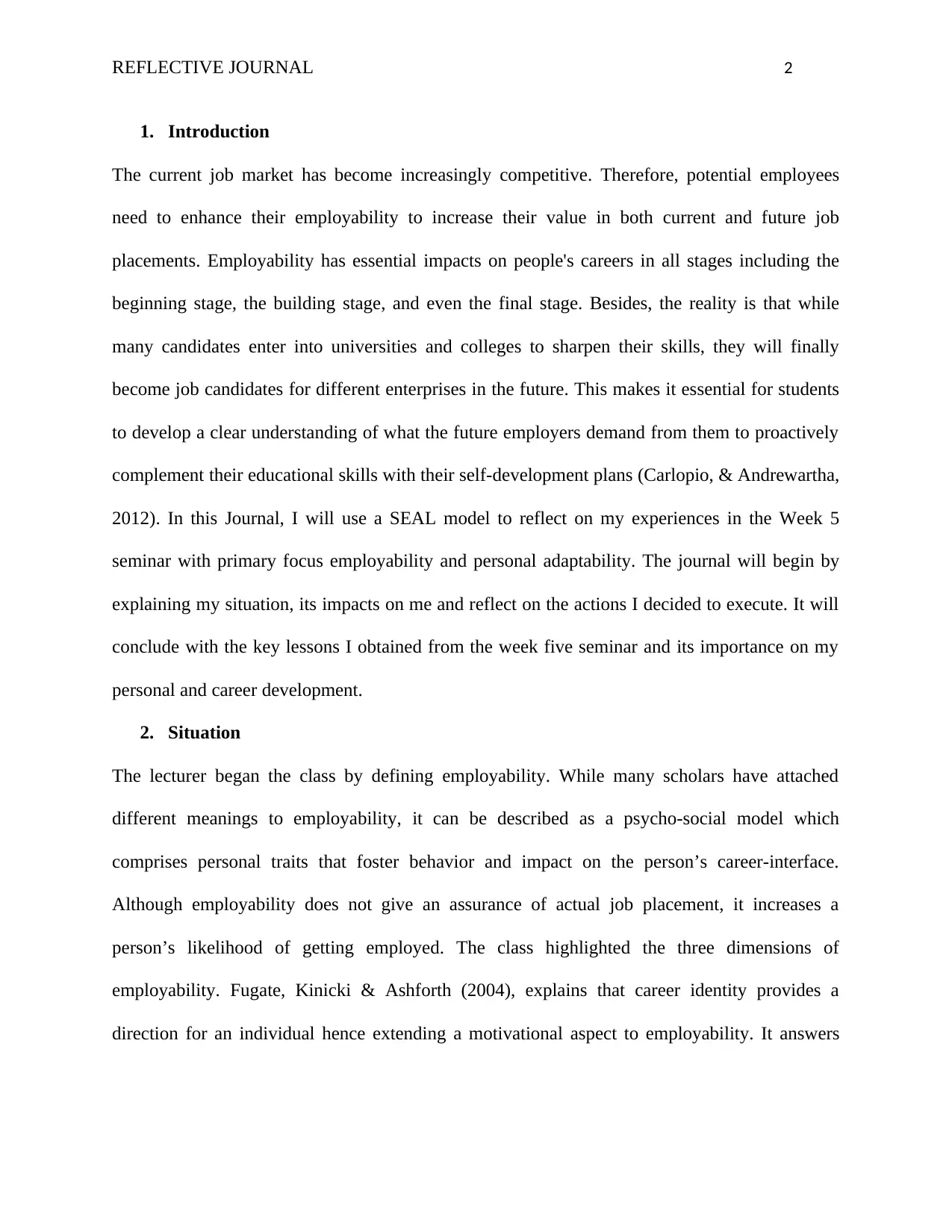
REFLECTIVE JOURNAL 2
1. Introduction
The current job market has become increasingly competitive. Therefore, potential employees
need to enhance their employability to increase their value in both current and future job
placements. Employability has essential impacts on people's careers in all stages including the
beginning stage, the building stage, and even the final stage. Besides, the reality is that while
many candidates enter into universities and colleges to sharpen their skills, they will finally
become job candidates for different enterprises in the future. This makes it essential for students
to develop a clear understanding of what the future employers demand from them to proactively
complement their educational skills with their self-development plans (Carlopio, & Andrewartha,
2012). In this Journal, I will use a SEAL model to reflect on my experiences in the Week 5
seminar with primary focus employability and personal adaptability. The journal will begin by
explaining my situation, its impacts on me and reflect on the actions I decided to execute. It will
conclude with the key lessons I obtained from the week five seminar and its importance on my
personal and career development.
2. Situation
The lecturer began the class by defining employability. While many scholars have attached
different meanings to employability, it can be described as a psycho-social model which
comprises personal traits that foster behavior and impact on the person’s career-interface.
Although employability does not give an assurance of actual job placement, it increases a
person’s likelihood of getting employed. The class highlighted the three dimensions of
employability. Fugate, Kinicki & Ashforth (2004), explains that career identity provides a
direction for an individual hence extending a motivational aspect to employability. It answers
1. Introduction
The current job market has become increasingly competitive. Therefore, potential employees
need to enhance their employability to increase their value in both current and future job
placements. Employability has essential impacts on people's careers in all stages including the
beginning stage, the building stage, and even the final stage. Besides, the reality is that while
many candidates enter into universities and colleges to sharpen their skills, they will finally
become job candidates for different enterprises in the future. This makes it essential for students
to develop a clear understanding of what the future employers demand from them to proactively
complement their educational skills with their self-development plans (Carlopio, & Andrewartha,
2012). In this Journal, I will use a SEAL model to reflect on my experiences in the Week 5
seminar with primary focus employability and personal adaptability. The journal will begin by
explaining my situation, its impacts on me and reflect on the actions I decided to execute. It will
conclude with the key lessons I obtained from the week five seminar and its importance on my
personal and career development.
2. Situation
The lecturer began the class by defining employability. While many scholars have attached
different meanings to employability, it can be described as a psycho-social model which
comprises personal traits that foster behavior and impact on the person’s career-interface.
Although employability does not give an assurance of actual job placement, it increases a
person’s likelihood of getting employed. The class highlighted the three dimensions of
employability. Fugate, Kinicki & Ashforth (2004), explains that career identity provides a
direction for an individual hence extending a motivational aspect to employability. It answers
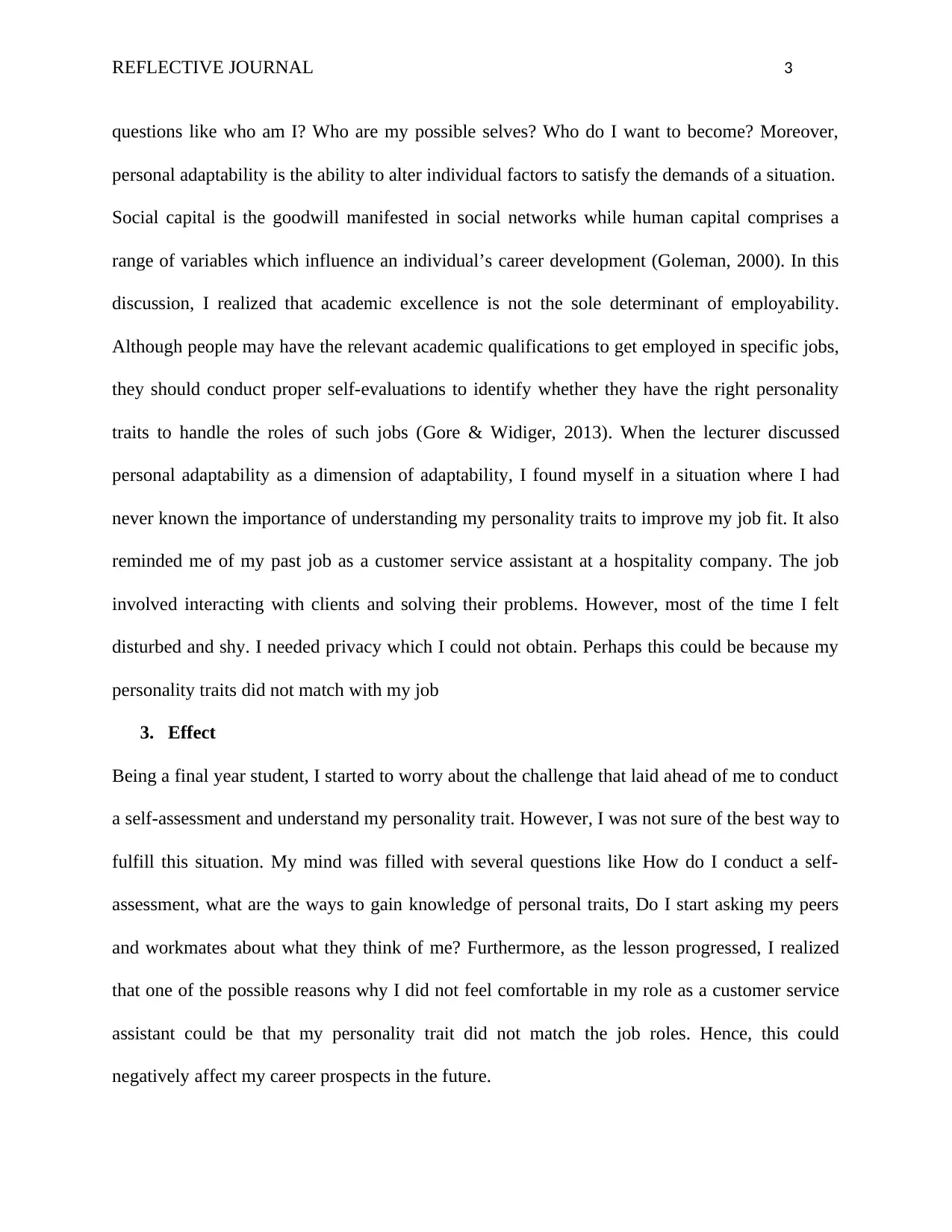
REFLECTIVE JOURNAL 3
questions like who am I? Who are my possible selves? Who do I want to become? Moreover,
personal adaptability is the ability to alter individual factors to satisfy the demands of a situation.
Social capital is the goodwill manifested in social networks while human capital comprises a
range of variables which influence an individual’s career development (Goleman, 2000). In this
discussion, I realized that academic excellence is not the sole determinant of employability.
Although people may have the relevant academic qualifications to get employed in specific jobs,
they should conduct proper self-evaluations to identify whether they have the right personality
traits to handle the roles of such jobs (Gore & Widiger, 2013). When the lecturer discussed
personal adaptability as a dimension of adaptability, I found myself in a situation where I had
never known the importance of understanding my personality traits to improve my job fit. It also
reminded me of my past job as a customer service assistant at a hospitality company. The job
involved interacting with clients and solving their problems. However, most of the time I felt
disturbed and shy. I needed privacy which I could not obtain. Perhaps this could be because my
personality traits did not match with my job
3. Effect
Being a final year student, I started to worry about the challenge that laid ahead of me to conduct
a self-assessment and understand my personality trait. However, I was not sure of the best way to
fulfill this situation. My mind was filled with several questions like How do I conduct a self-
assessment, what are the ways to gain knowledge of personal traits, Do I start asking my peers
and workmates about what they think of me? Furthermore, as the lesson progressed, I realized
that one of the possible reasons why I did not feel comfortable in my role as a customer service
assistant could be that my personality trait did not match the job roles. Hence, this could
negatively affect my career prospects in the future.
questions like who am I? Who are my possible selves? Who do I want to become? Moreover,
personal adaptability is the ability to alter individual factors to satisfy the demands of a situation.
Social capital is the goodwill manifested in social networks while human capital comprises a
range of variables which influence an individual’s career development (Goleman, 2000). In this
discussion, I realized that academic excellence is not the sole determinant of employability.
Although people may have the relevant academic qualifications to get employed in specific jobs,
they should conduct proper self-evaluations to identify whether they have the right personality
traits to handle the roles of such jobs (Gore & Widiger, 2013). When the lecturer discussed
personal adaptability as a dimension of adaptability, I found myself in a situation where I had
never known the importance of understanding my personality traits to improve my job fit. It also
reminded me of my past job as a customer service assistant at a hospitality company. The job
involved interacting with clients and solving their problems. However, most of the time I felt
disturbed and shy. I needed privacy which I could not obtain. Perhaps this could be because my
personality traits did not match with my job
3. Effect
Being a final year student, I started to worry about the challenge that laid ahead of me to conduct
a self-assessment and understand my personality trait. However, I was not sure of the best way to
fulfill this situation. My mind was filled with several questions like How do I conduct a self-
assessment, what are the ways to gain knowledge of personal traits, Do I start asking my peers
and workmates about what they think of me? Furthermore, as the lesson progressed, I realized
that one of the possible reasons why I did not feel comfortable in my role as a customer service
assistant could be that my personality trait did not match the job roles. Hence, this could
negatively affect my career prospects in the future.
⊘ This is a preview!⊘
Do you want full access?
Subscribe today to unlock all pages.

Trusted by 1+ million students worldwide
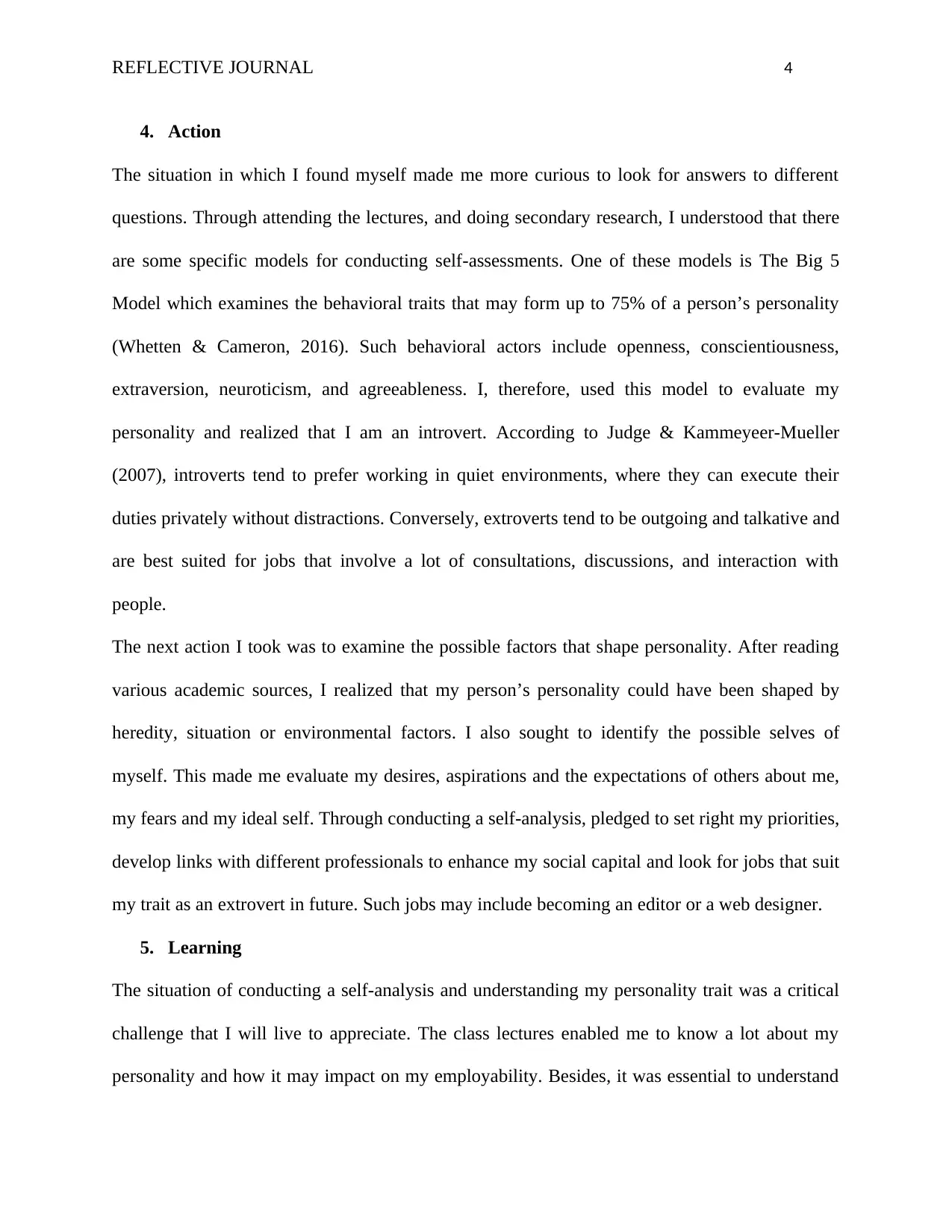
REFLECTIVE JOURNAL 4
4. Action
The situation in which I found myself made me more curious to look for answers to different
questions. Through attending the lectures, and doing secondary research, I understood that there
are some specific models for conducting self-assessments. One of these models is The Big 5
Model which examines the behavioral traits that may form up to 75% of a person’s personality
(Whetten & Cameron, 2016). Such behavioral actors include openness, conscientiousness,
extraversion, neuroticism, and agreeableness. I, therefore, used this model to evaluate my
personality and realized that I am an introvert. According to Judge & Kammeyeer-Mueller
(2007), introverts tend to prefer working in quiet environments, where they can execute their
duties privately without distractions. Conversely, extroverts tend to be outgoing and talkative and
are best suited for jobs that involve a lot of consultations, discussions, and interaction with
people.
The next action I took was to examine the possible factors that shape personality. After reading
various academic sources, I realized that my person’s personality could have been shaped by
heredity, situation or environmental factors. I also sought to identify the possible selves of
myself. This made me evaluate my desires, aspirations and the expectations of others about me,
my fears and my ideal self. Through conducting a self-analysis, pledged to set right my priorities,
develop links with different professionals to enhance my social capital and look for jobs that suit
my trait as an extrovert in future. Such jobs may include becoming an editor or a web designer.
5. Learning
The situation of conducting a self-analysis and understanding my personality trait was a critical
challenge that I will live to appreciate. The class lectures enabled me to know a lot about my
personality and how it may impact on my employability. Besides, it was essential to understand
4. Action
The situation in which I found myself made me more curious to look for answers to different
questions. Through attending the lectures, and doing secondary research, I understood that there
are some specific models for conducting self-assessments. One of these models is The Big 5
Model which examines the behavioral traits that may form up to 75% of a person’s personality
(Whetten & Cameron, 2016). Such behavioral actors include openness, conscientiousness,
extraversion, neuroticism, and agreeableness. I, therefore, used this model to evaluate my
personality and realized that I am an introvert. According to Judge & Kammeyeer-Mueller
(2007), introverts tend to prefer working in quiet environments, where they can execute their
duties privately without distractions. Conversely, extroverts tend to be outgoing and talkative and
are best suited for jobs that involve a lot of consultations, discussions, and interaction with
people.
The next action I took was to examine the possible factors that shape personality. After reading
various academic sources, I realized that my person’s personality could have been shaped by
heredity, situation or environmental factors. I also sought to identify the possible selves of
myself. This made me evaluate my desires, aspirations and the expectations of others about me,
my fears and my ideal self. Through conducting a self-analysis, pledged to set right my priorities,
develop links with different professionals to enhance my social capital and look for jobs that suit
my trait as an extrovert in future. Such jobs may include becoming an editor or a web designer.
5. Learning
The situation of conducting a self-analysis and understanding my personality trait was a critical
challenge that I will live to appreciate. The class lectures enabled me to know a lot about my
personality and how it may impact on my employability. Besides, it was essential to understand
Paraphrase This Document
Need a fresh take? Get an instant paraphrase of this document with our AI Paraphraser
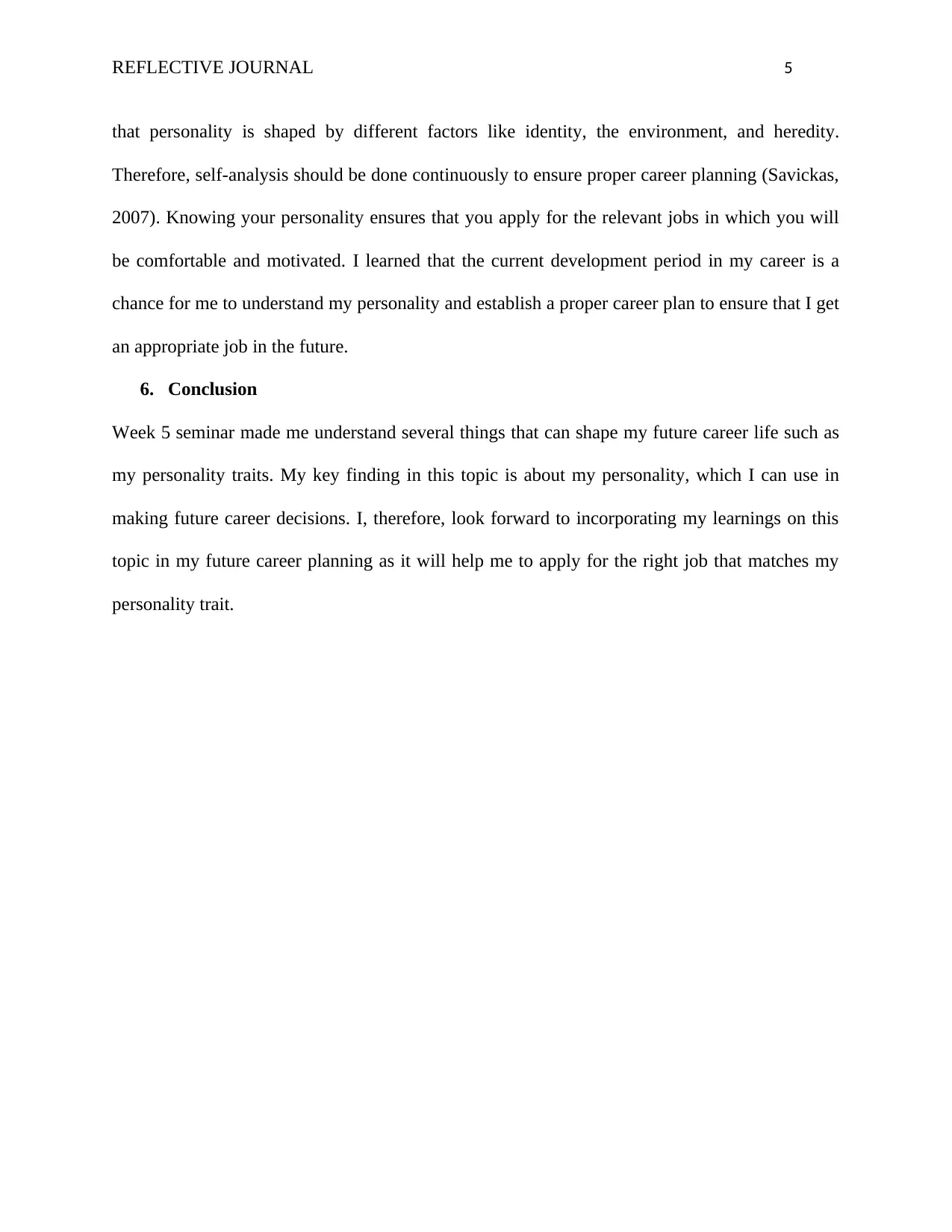
REFLECTIVE JOURNAL 5
that personality is shaped by different factors like identity, the environment, and heredity.
Therefore, self-analysis should be done continuously to ensure proper career planning (Savickas,
2007). Knowing your personality ensures that you apply for the relevant jobs in which you will
be comfortable and motivated. I learned that the current development period in my career is a
chance for me to understand my personality and establish a proper career plan to ensure that I get
an appropriate job in the future.
6. Conclusion
Week 5 seminar made me understand several things that can shape my future career life such as
my personality traits. My key finding in this topic is about my personality, which I can use in
making future career decisions. I, therefore, look forward to incorporating my learnings on this
topic in my future career planning as it will help me to apply for the right job that matches my
personality trait.
that personality is shaped by different factors like identity, the environment, and heredity.
Therefore, self-analysis should be done continuously to ensure proper career planning (Savickas,
2007). Knowing your personality ensures that you apply for the relevant jobs in which you will
be comfortable and motivated. I learned that the current development period in my career is a
chance for me to understand my personality and establish a proper career plan to ensure that I get
an appropriate job in the future.
6. Conclusion
Week 5 seminar made me understand several things that can shape my future career life such as
my personality traits. My key finding in this topic is about my personality, which I can use in
making future career decisions. I, therefore, look forward to incorporating my learnings on this
topic in my future career planning as it will help me to apply for the right job that matches my
personality trait.
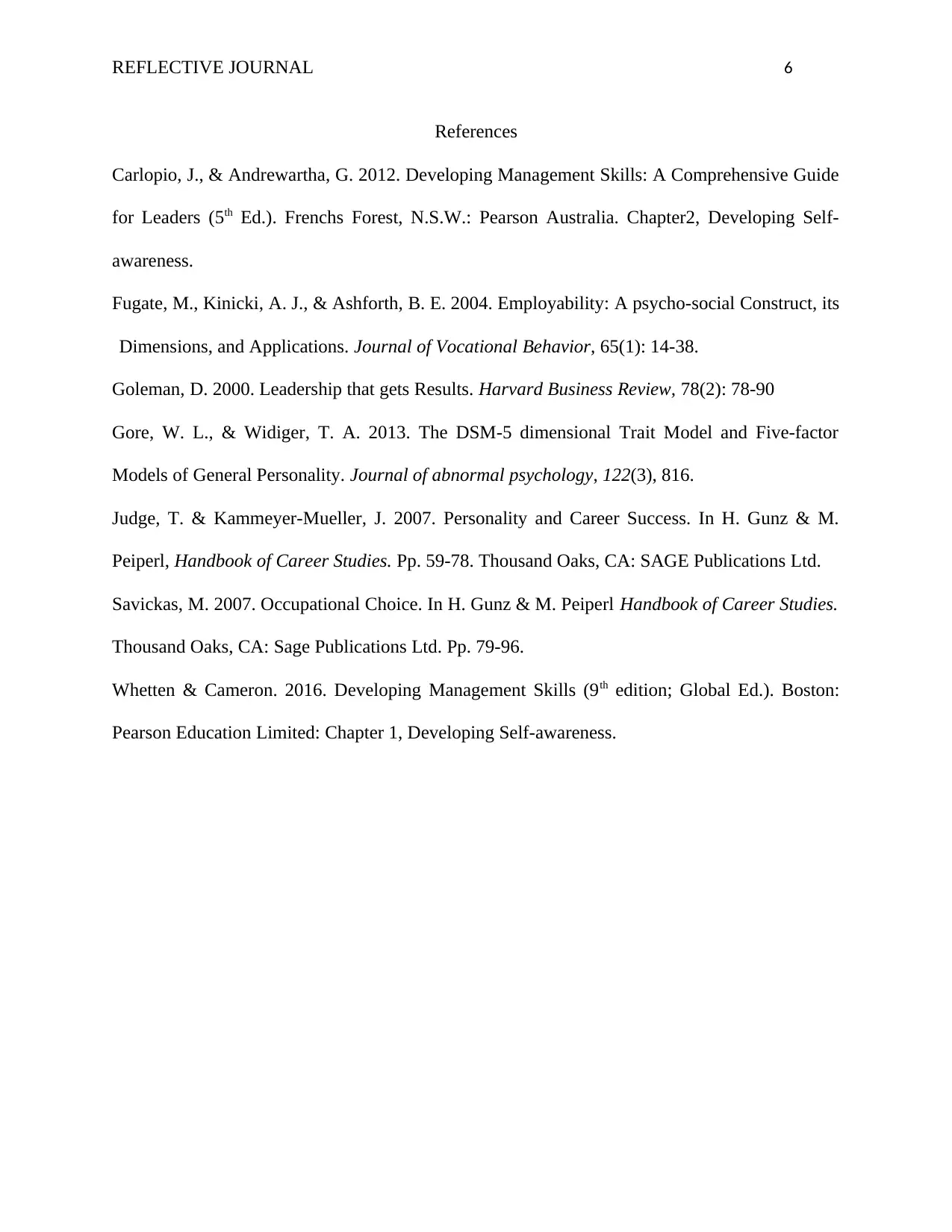
REFLECTIVE JOURNAL 6
References
Carlopio, J., & Andrewartha, G. 2012. Developing Management Skills: A Comprehensive Guide
for Leaders (5th Ed.). Frenchs Forest, N.S.W.: Pearson Australia. Chapter2, Developing Self-
awareness.
Fugate, M., Kinicki, A. J., & Ashforth, B. E. 2004. Employability: A psycho-social Construct, its
Dimensions, and Applications. Journal of Vocational Behavior, 65(1): 14-38.
Goleman, D. 2000. Leadership that gets Results. Harvard Business Review, 78(2): 78-90
Gore, W. L., & Widiger, T. A. 2013. The DSM-5 dimensional Trait Model and Five-factor
Models of General Personality. Journal of abnormal psychology, 122(3), 816.
Judge, T. & Kammeyer-Mueller, J. 2007. Personality and Career Success. In H. Gunz & M.
Peiperl, Handbook of Career Studies. Pp. 59-78. Thousand Oaks, CA: SAGE Publications Ltd.
Savickas, M. 2007. Occupational Choice. In H. Gunz & M. Peiperl Handbook of Career Studies.
Thousand Oaks, CA: Sage Publications Ltd. Pp. 79-96.
Whetten & Cameron. 2016. Developing Management Skills (9th edition; Global Ed.). Boston:
Pearson Education Limited: Chapter 1, Developing Self-awareness.
References
Carlopio, J., & Andrewartha, G. 2012. Developing Management Skills: A Comprehensive Guide
for Leaders (5th Ed.). Frenchs Forest, N.S.W.: Pearson Australia. Chapter2, Developing Self-
awareness.
Fugate, M., Kinicki, A. J., & Ashforth, B. E. 2004. Employability: A psycho-social Construct, its
Dimensions, and Applications. Journal of Vocational Behavior, 65(1): 14-38.
Goleman, D. 2000. Leadership that gets Results. Harvard Business Review, 78(2): 78-90
Gore, W. L., & Widiger, T. A. 2013. The DSM-5 dimensional Trait Model and Five-factor
Models of General Personality. Journal of abnormal psychology, 122(3), 816.
Judge, T. & Kammeyer-Mueller, J. 2007. Personality and Career Success. In H. Gunz & M.
Peiperl, Handbook of Career Studies. Pp. 59-78. Thousand Oaks, CA: SAGE Publications Ltd.
Savickas, M. 2007. Occupational Choice. In H. Gunz & M. Peiperl Handbook of Career Studies.
Thousand Oaks, CA: Sage Publications Ltd. Pp. 79-96.
Whetten & Cameron. 2016. Developing Management Skills (9th edition; Global Ed.). Boston:
Pearson Education Limited: Chapter 1, Developing Self-awareness.
⊘ This is a preview!⊘
Do you want full access?
Subscribe today to unlock all pages.

Trusted by 1+ million students worldwide
1 out of 6
Related Documents
Your All-in-One AI-Powered Toolkit for Academic Success.
+13062052269
info@desklib.com
Available 24*7 on WhatsApp / Email
![[object Object]](/_next/static/media/star-bottom.7253800d.svg)
Unlock your academic potential
Copyright © 2020–2025 A2Z Services. All Rights Reserved. Developed and managed by ZUCOL.




